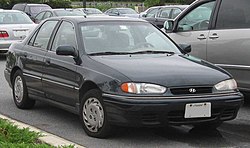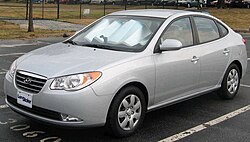Hyundai Elantra
 | |
| Manufacturer | Hyundai Motor Company |
|---|---|
| Production | 1991–present |
| Assembly | Ulsan, Korea |
| Predecessor | Hyundai Excel |
| Successor | Hyundai i30 (Hatchback only) |
| Class | Compact |
| Layout | FF layout |
The Hyundai Elantra (sold in South Korea as the Avante) is a compact car from Hyundai of South Korea launched in 1991.
The Elantra was formerly sold as the Lantra and the Avante in some Australian and European markets.
This gave rise to disagreement from other motor manufacturers, and the name was standardized as "Elantra" worldwide in 2001.
Between 1996 and 1998, the Elantra was marketed as the Bimantara Cakra (1.5 litre petrol) and the Bimantara Nenggala (1.8 litre petrol) in Indonesia.
The Hyundai Elantra is listed as United States Environmental Protection Agency (EPA) Picks Ten Most Fuel Efficient Vehicles. The Elantra ranked #2 in 2006 and 2007 in the category of most fuel efficient sedans, and also was ranked as the most efficient non-hybrid mid-sized sedan.
Hyundai Elantra SE awarded 2008 Consumer Reports "top pick". Hyundai Elantra SE was among the top 10 vehicles for 2008 unveiled in the magazine's issue. The magazine's annual ratings, based on road tests and predicted safety and reliability are considered highly influential among consumers.
Hyundai Elantra earned Consumer Reports' 'excellent' rating in predicted reliability. Hyundai Elantra SE is Consumer Reports top-ranked 2008 vehicle amongst 19 other compacts and subcompacts (however, the less expensive GLS trim line, without the electronic stability control standard on the SE trim line, and with less sporty tires, was ranked closer to the middle of the group). Beating out such high-quality competitors as the Honda Civic, Toyota Corolla and Toyota Prius.First generation (1991-1995)
 | |
| Also called | Hyundai Lantra |
|---|---|
| Production | 1991-1995 |
| Body style(s) | 4-door sedan |
| Engine(s) | 1.6/1.8L 113/124 hp I4 |
| Transmission(s) | 5-speed manual 4-speed automatic |
| Wheelbase | 98.4 in (2500 mm) |
| Length | 1991-93: 171.6 in (4359 mm) 1994-95: 172.8 in (4390 mm) |
| Width | 1991-93: 65.9 in (1673 mm) 1994-95: 66.1 in (1680 mm) |
| Height | 1991-93: 54.5 in (1371 mm) 1994-95: 52 in (1320 mm) |
| Curb weight | 2522 lb (1144 kg) |
| Fuel capacity | 13.7 US gal (52 L, 11 imp gal) |
Launched in 1991 (1992 in the United States) to compete with the Honda Civic and Toyota Corolla, the Elantra (codename J1) received a mid-term facelift in 1993. It was originally designed to replace the Hyundai Excel, but the Excel ended up being sold for four seasons until being replaced by the Accent.
The Elantra was powered by a Mitsubishi-designed 1.6 L (1596 cc) straight-4 This DOHC 16-valve 1.6 L unit produced 113 hp (84 kW) at 6000 rpm and could push the Elantra to 60 mph (97 km/h) in 9.5 seconds. The quarter-mile (0.4 km) run took 17.1 seconds and produced 80 mph (129 km/h). Top speed was 116 mph (187 km/h). The Elantra got 22 mpg[clarification needed](10.7 L/100 km) in the city cycle. Starting in 1993 there was also a Mitsubishi-designed 1.8 L (1836 cc) straight-4 engine available the 1.8L unit that produced 124 hp (99 kW) at 6000 rpm.
Second generation (1996–2000)
 | |
| Also called | Hyundai Avante(South Korea) Hyundai Lantra Bimantara Cakra Bimantara Nenggala |
|---|---|
| Production | 1996–2000 |
| Body style(s) | 4-door station wagon 4-door sedan |
| Engine(s) | 1.8/2.0L 137/140 hp I4 (104 kW) |
| Transmission(s) | 5-speed manual 4-speed automatic |
| Wheelbase | 100.4 in (2540 mm) |
| Length | Sedan: 174.0 in (4419 mm) Wagon: 175.2 in (4450 mm) |
| Width | 66.9 in (1676 mm) |
| Height | Sedan: 54.9 in (1371 mm) 1996-97 Wagon: 57.4 in (1458 mm) 1998-2000 Wagon: 58.8 in (1494 mm) |
| Fuel capacity | 14.5 US gal (55 L, 12 imp gal) |
Launched in 1995, the second generation (codename J2) was offered as a sedan and station wagon. It was sold in the Korean market as the Avante in sedan form and Avante Touring in station wagon bodystyle.
At launch, a 1.5-litre Alpha DOHC (107 hp) and 1.8-litre Beta DOHC (128 hp) gasoline engine were available on the domestic market. Later, a 1.5-litre lean-burn (98 hp) gasoline engine based on Alpha DOHC engine was added. A mid-life facelift arrived for 1999. The Philippine version, as well as in some European markets, had the 1.6 (1599 cc) Beta, which produced 116 hp (87 kW) .
In Australia, the station wagon was called the Lantra Sportswagon and was a popular model of Hyundai.
A 2 litre engine option became available near the end of its production run. In Australia the GLS model was an upgrade on the GL model, and supplies 2 litre engine, velour trim, softer cloth seats, and Hyundai's version of mag wheels. Also the GLS had matching paint on rear number plate light holder and side mirrors.
Third generation (2001–2006)
 | |
| Also called | Hyundai Avante XD (South Korea) Bimantara Cakra |
|---|---|
| Production | 2001-2006 |
| Body style(s) | 4-door hatchback 4-door sedan |
| Engine(s) | 1.6 L I4 1.8 L I4 2.0 L I4 2.0 L Diesel I4 |
| Transmission(s) | 5-speed manual 4-speed automatic |
| Wheelbase | 102.7 in (2590 mm) |
| Length | 2004-06 Sedan: 178.1 in (4521 mm) 2004-06 Hatchback: 177.9 in (4495 mm) 2001-03: 177.1 in (4500 mm) |
| Width | Hatchback & 2001-03 Sedan: 67.7 in (1720 mm) 2004-06 Sedan: 67.9 in (1701 mm) |
| Height | 56.1 in (1422 mm) |
| Fuel capacity | 14.5 US gal (55 L, 12 imp gal) |
| Related | Hyundai Tucson Hyundai Matrix Kia Spectra Kia Sportage |
An all-new model (codename XD) was launched in 2001. The wagon was dropped in favor of a five-door hatchback. Starting in 2001, all American models came with standard front and front side airbags, air conditioning, power locks, power windows and power steering. This simplified dealer inventories and repairs and also sought to improve Hyundai's image of 'value' cars. In 2004, the Elantra received a facelift for all models (codename XD2). The facelift gave the Elantra new headlights and taillights, a new grille, new front and rear bumpers, a refreshed hood and trunk, and a refreshed dashboard.
The GLS trim is the standard trim for the Elantra. The top of the line model, the GT trim, came with a stiffer suspension, leather seats, fog lights, alloy wheels, lip spoiler and blue-lit instrument cluster. It was offered as a hatchback since 2001. The only options for the GT trim were an automatic transmission, power moonroof and anti-lock brakes with traction control. The only major option was a Kenwood MP3/CD deck. The GT trim sedan was introduced in 2003 and discontinued in 2005. The GT trim was replaced with the Limited trim for the 2006 model year. The limited trim featured new paint colors, a chrome vertical grille, leather interior with leather steering wheel and leather shifter, and wood trim. The Limited trim did not feature alloy wheels, only steel rims with a 6-spoke cover featured in the GLS model. The GT trim for the five door was produced for the remainder of the 2006 model year.
The Elantra is available with 1.6, 1.8 and 2.0 L gasoline engines and a 2.0 L turbodiesel. North American models are only available with the 2.0L gasoline engine. The 1.8 engine is a 1.6 engine modified for the New Zealand market.
While compact on the outside, it is listed by the United States Environmental Protection Agency as a mid-size car because of a spacious interior. Although the basic powertrain design has changed little since the second generation, successive improvements have improved fuel economy from an EPA rating of 24/33 to 25/33 and the current 27/34 for manual transmissions, with automatic producing 2-3mpg fewer. Horsepower also improved from 135 hp (100 kW) to 138 hp (102 kW) and torque from 132 to 136 mainly thanks to the addition of continuously variable valve timing (CVVT) in 2004. Originally, the horsepower rating was misrepresented as 140 hp (104 kW). In 2006 the Elantra was offered with a SULEV emission rated engine in some U.S. states.
Fourth generation (2007 to current)
 | |
| Also called | Hyundai Avante (South Korea) Hyundai i30 (Europe, For Wagon) Elantra Touring (USDM 5-door) Hyundai Yuedong (China) |
|---|---|
| Production | 2007– |
| Body style(s) | 4-door sedan 4-door station wagon |
| Engine(s) | 1.6 L Gamma I4 2.0 L Beta II I4 1.6 L Diesel I4 |
| Transmission(s) | 5-speed manual 4-speed automatic |
| Wheelbase | 104.3 in (2641 mm) Touring: 2700 mm (106.3 in) |
| Length | 177.4 in (4495 mm) Touring: 4475 mm (176.2 in) |
| Width | 69.9 in (1752 mm) Touring: 1765 mm (69.5 in) |
| Height | 58.3 in (1473 mm) Touring: 1519 mm (59.8 in) |
| Related | Hyundai i30 Kia cee'd |
In 2006, a redesigned Elantra sedan (codename HD) debuted at the New York Auto Show and went on sale late in the fall. The engine lineup includes 1.6 L Gamma and 2.0 L Beta II gasoline engines, and a 1.6 L turbo diesel engine. Only the 2.0 L engine is offered in North America. All engines feature improved fuel economy over previous versions. A five-speed manual transmission is standard and a four-speed automatic is optional. In North America, the base GLS trim, unlike the previous year's, does not include air conditioning as standard equipment, but adds side curtain airbags (previously front and side only), active head restraints and all-disc brakes with 4-channel ABS. The Elantra also offers the most interior room in its class, leading the US EPA to classify it as a mid-size car.
For 2008, the Limited trim level was dropped, leaving GLS and SE as the two remaining trim choices in the U.S. The SE trim includes features not available on the GLS, such as telescopic steering wheel and electronic stability control, with sunroof and leather as options. According to Consumer Reports testing, the SE trim has significantly better handling and braking, moving it to the top of their small car ratings, while the GLS trim was closer to the middle of the pack.
A wagon called the "Elantra Touring" will be sold in North America starting in the 2009 model year. This car is sold in other parts of the world as the Hyundai i30 cw.
Canadian trim levels are different from the U.S. models and are as follows.
The base model L offers a base package with a four speaker CD/MP3/Aux stereo and front airbags. This trim also includes power windows in the front with manual windows in the rear. Moving up to the GL will get you heated mirrors, AC, power windows all around, heated seats, a six speaker CD/MP3/Aux stereo, wheel mounted cruise control and keyless entry with alarm. The GLS trim adds wheel mounted audio controls, ABS, disc brakes, and front seat-mounted side-impact and roof-mounted side curtain airbags. The sporty GLS with Sport Package adds a rear spoiler, power tilt/sliding moonroof, 16” alloy wheels, fog lights, trip computer and a leather wrapped steering wheel and leather shifter. The final trim level, the Limited, adds leather seats, a telescopic steering wheel and automatic climate control.









No comments:
Post a Comment